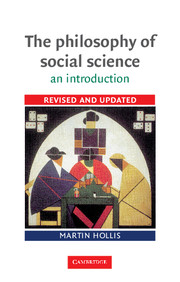Book contents
- Frontmatter
- 1 Introduction: problems of structure and action
- 2 Discovering truth: the rationalist way
- 3 Positive science: the empiricist way
- 4 Ants, spiders and bees: a third way?
- 5 Systems and functions
- 6 Games with rational agents
- 7 Understanding social action
- 8 Self and roles
- 9 Explaining and understanding
- 10 A value-neutral social science?
- 11 Rationality and relativism
- 12 Conclusion: two stories to tell
- Bibliography
- Index
2 - Discovering truth: the rationalist way
Published online by Cambridge University Press: 03 July 2012
- Frontmatter
- 1 Introduction: problems of structure and action
- 2 Discovering truth: the rationalist way
- 3 Positive science: the empiricist way
- 4 Ants, spiders and bees: a third way?
- 5 Systems and functions
- 6 Games with rational agents
- 7 Understanding social action
- 8 Self and roles
- 9 Explaining and understanding
- 10 A value-neutral social science?
- 11 Rationality and relativism
- 12 Conclusion: two stories to tell
- Bibliography
- Index
Summary
Sir Francis Bacon, often hailed as the father of modern scientific method, distinguished two ways of discovering truth. In his First Book of Aphorisms, published in 1620, he declared:
There are and can be only two ways of searching into and discovering truth. The one flies from the senses and particulars to the most general axioms, and from these principles, the truth of which it takes for settled and immovable, proceeds to judgement and the discovery of middle axioms. And this way is now in fashion. The other derives axioms from the senses and particulars, rising by a gradual and unbroken ascent, so that it arrives at the most general axioms last of all. This is the true way, but as yet untried.
The truth to be searched into was truth about nature, meaning the universe as God had created and furnished it. Both ways were ways of discovering the true order in nature by applying Reason scientifically. They differed sharply in their analysis of Reason and how to apply it, but they agreed on the project, that of constructing a new science based on absolutely certain truths. New ideas of Reason were accompanied by new ideas of nature and led to new ideas about human nature and society.
I start in the seventeenth century because that is when our modern intellectual world coalesced. The scientific revolution was already in full progress. In astronomy, for instance, telescopes wielded by Kepler and Galileo had long since smashed the crystal spheres, once believed to rotate around the earth. But it took some time for thinkers to realise that the new science was so systematically at odds with the old that nothing could be taken for granted.
- Type
- Chapter
- Information
- The Philosophy of Social ScienceAn Introduction, pp. 23 - 39Publisher: Cambridge University PressPrint publication year: 1994



